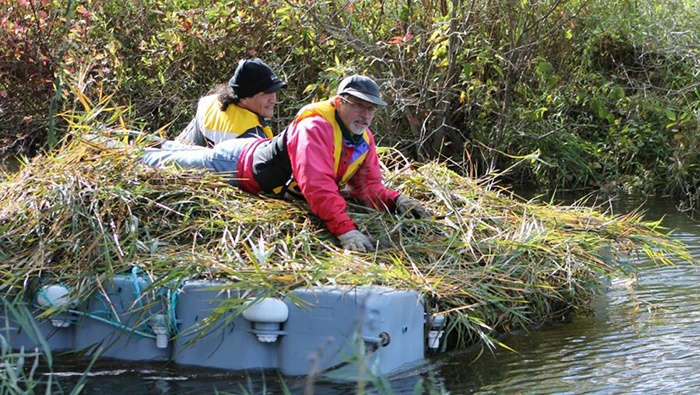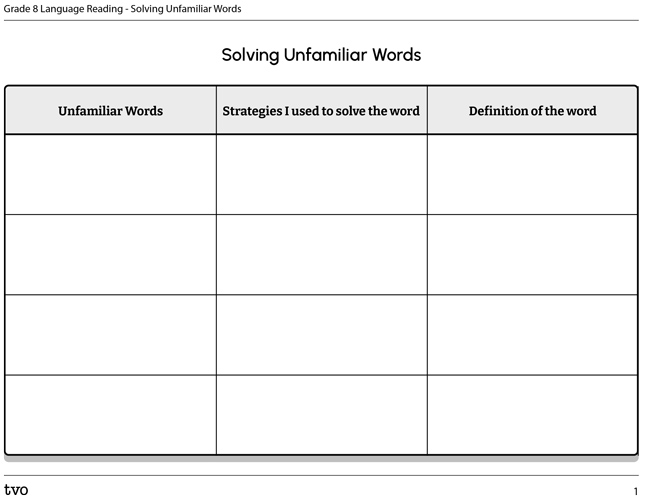Minds On
What does it mean?

Explore the list of words.
- fending off
- invasive plant
- dominating
- barge
- confined
- unfettered
- fragments
- drastically
- ecologist
- monoculture
Are you familiar with any of the words? What do you think they mean?
Describe the strategies you used to understand unfamiliar words.
You can record your responses using a method of your choice.
Action
Understanding unfamiliar
As readers, there are times that we come across words that are unfamiliar. When this happens, we can use different cueing systems to help us solve unfamiliar words. Let’s explore three different types of cues we can use: semantic, syntactic, and graphophonic.

Semantic cues
Semantic cues are related to the meaning of a word and involve using familiar words, phrases, sentences, and visuals that activate our existing knowledge (e.g., prefixes, suffixes, base words).
Sometimes, the dogs in our neighborhood bark together to create a cacophony that wakes me up in the morning.
Use the following semantic cues to help you determine the meaning of the word cacophony. Press the ‘Hint’ buttons following each cue for examples.
- Use the words around the unfamiliar word for clues.
-
Examples: bark, wake
- Find a synonym of cacophony.
-
Example: racket
- Find a picture clue.
Syntactic cues
When we use syntactic (language structure) cues, we examine word order, language patterns and rules (grammar), and punctuation to solve unknown words.
Sometimes, the dogs in our neighborhood bark together to create a cacophony that wakes me up in the morning.
Use the following syntactic cues to help you determine the meaning of the word cacophony. Press the ‘Hint’ buttons bellow each following cue for examples.
- Where does the word appear in the sentence?
-
After the word create and near the end of the sentence.
- What part of speech is this word?
-
A noun.
Graphophonic cues
When we use graphophonic (phonological and graphic) cues we examine letter or sound relationships and word patterns (e.g., similarities between words with common spelling patterns and unknown words; words within words; syllables).
Sometimes, the dogs in our neighborhood bark together to create a cacophony that wakes me up in the morning.
Use the following graphophonic cues to help you determine the meaning of the word cacophony:
- What are the beginning and end sounds?
- Does a portion of this word look familiar to me?
Explore the article, Phragmites are Ontario's worst invasive plants — but the Phragbusters are on the case.

Press TVO.org to access Phragmites are Ontario's worst invasive plants — but the Phragbusters are on the case.
TVO dot org (Opens in a new tab)Create a list of the unfamiliar words that you encounter and describe the strategies (semantic, syntactic and/or graphophonic) you used to solve each one. Use a dictionary to define each word.
Use the Solving Unfamiliar Words template below to record your ideas or another method of your choice.
Consolidation
Bringing it all together
Use the following questions to reflect on your learning. You can record your responses using a method of your choice.
- Review the unfamiliar words that you listed in the Action section. What happened when you learned the meaning of these words? How did it change your understanding of a text?
- Why is important to know how to use different cueing systems to solve unfamiliar words?
- Which cueing system(s) do you use most often to solve unfamiliar words? Why do you think this is?

Reflection
As you read the following descriptions, select the one that best describes your current understanding of the learning in this activity. Press the corresponding button once you have made your choice.
I feel...
Now, expand on your ideas by recording your thoughts using a voice recorder, speech-to-text, or writing tool.
When you review your notes on this learning activity later, reflect on whether you would select a different description based on your further review of the material in this learning activity.

